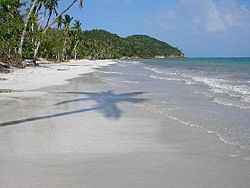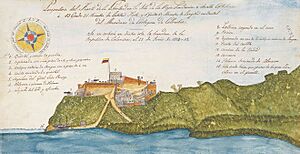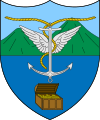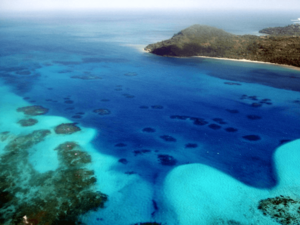Providencia Island, Colombia facts for kids
Quick facts for kids
Old Providence Island
Isla de Providencia
Old Providence
|
||
|---|---|---|

Manzanillo beach
|
||
|
||
| Country | ||
| Department | San Andrés, Providencia and Santa Catalina | |
| Area | ||
| • Total | 17.0 km2 (6.6 sq mi) | |
| Elevation | 360 m (1,180 ft) | |
| Population
(2007)
|
||
| • Total | 5,011 | |
| • Density | 294.8/km2 (763.4/sq mi) | |
| Estimate | ||
| Time zone | Colombia Time (COT) | |
| • Summer (DST) | none | |
| Languages | San Andrés–Providencia Creole, Spanish | |
Providencia, also known as Old Providence, is a beautiful, mountainous island in the Caribbean Sea. It is part of Colombia and lies between Costa Rica and Jamaica. Providencia's highest point is about 360 meters (1,180 feet) above sea level.
A smaller island called Santa Catalina Island is connected to Providencia by a 100-meter (330-foot) footbridge. Together, these two islands cover an area of 22 square kilometers (8.5 square miles). In 2005, about 4,927 people lived here. The island has an airport called El Embrujo Airport, which the Colombian government plans to make bigger for international flights.
In 1629, English Puritan settlers started a colony on the island. However, Spain took control of it in 1641. You can still find old forts and cannons on Santa Catalina Island today. In November 2020, Hurricane Iota hit the island very hard. About 98% of the buildings and structures were destroyed. This made it one of the strongest storms to ever hit Colombia.
Contents
A Look at the Early Colony
The first English colony on Providencia faced many challenges. It had problems with planning and disagreements among its leaders. The colony also struggled with money. The Puritans hoped to create a successful and religious base here. They even thought it would do better than the Massachusetts Bay Colony in North America.
This colony became known for its involvement in the slave trade. It was one of the first places where the English started using Africans as lifelong slaves. Before this, many workers were indentured servants who worked for a set number of years.
Important People in the Colony
Some well-known people lived on Providencia. These included governors like Nathaniel Butler and Philip Bell. Philip Bell was the first governor, but he was later replaced. Many of these leaders had experience with England's efforts to start colonies and trade. They had worked with companies like the Virginia Company before.
We can learn about life on the island from stories told by enslaved people. They sometimes complained about eating turtles all the time! Life included church services and trading with English ships. People also hoped for attacks on Spanish ships by privateers. Enslaved Africans and Native Americans grew tobacco on the island. The island's fresh water and surrounding seas provided fish and turtles for food.
The main trading port had several small forts. These forts were built around the harbor and at the bay's entrance. There were about fourteen forts in total.
Privateering and Island Defense

Because the colony faced money problems, some people turned to privateering. Privateering meant attacking and stealing from enemy ships, usually with permission from their own government. This might seem strange for Puritans, but it was a way to make money. Even though England and Spain were not officially at war, there was a lot of tension between them.
Governor Nathaniel Butler spent much of his time dealing with privateers. He hoped this would help the colony's economy and make the colonists happier. He was also worried that English and Dutch activities in Spanish-controlled areas would cause trouble.
By 1638, the island focused on defense. People expected a Spanish attack within a year. Some men went on privateering trips themselves. A special council was even created to plan for war. Unlike other English colonies, Providencia had to rely on military planning more. However, many privateering trips were not successful because the sailors lacked experience.
Later, the famous privateer Henry Morgan used Providencia as a base. He launched attacks from here, including a raid on Panama. Some rumors say that much of his hidden treasure is still on the island. Many places on Providencia are named after Morgan.
The People of Providencia
About 5,000 to 6,000 people live on Providencia. Even though the island is part of Colombia, many residents feel more connected to the Caribbean culture. A lot of people follow the Rastafari way of life.
Most islanders speak English or San Andrés–Providencia Creole. This creole language is similar to languages spoken in Belize and Jamaica. They speak this more often than Spanish, which is the main language of Colombia. There is also a unique local sign language called Provisle.
Around 2015, the island was not directly affected by major conflicts in Colombia. However, some islanders faced challenges finding jobs. Because of their excellent seafaring skills and knowledge of the local waters, some young men were recruited for activities that led them to be in jails abroad or disappear. This was due to the lack of other work opportunities on the island.
Island Environment
The Old Providence McBean Lagoon National Natural Park is a special protected area on the island. It covers 995 hectares (about 2,459 acres) on the northeast side of Providencia. This National Park includes amazing coral reefs, small islands called cays, mangrove forests, lagoons, and tropical dry forests. There is a small visitor center on Crab Cay. From there, you can see the beautiful barrier reef and the waters around the cay.
A unique group of black land crabs lives on the island. Every April or May, these crabs make a special journey. They live in the hills and travel all the way down to the sea to lay their eggs. This is called their breeding migration.
Providencia is at the center of the Seaflower Biosphere Reserve. This is a huge protected marine area recognized by UNESCO. It covers 10% of the entire Caribbean Sea! This reserve is very important for nature because it has some of the world's greatest variety of sea life. It includes the Archipelago of San Andrés, Providencia and Santa Catalina and other distant reefs and cays.
See also
 In Spanish: Isla de Providencia para niños
In Spanish: Isla de Providencia para niños



